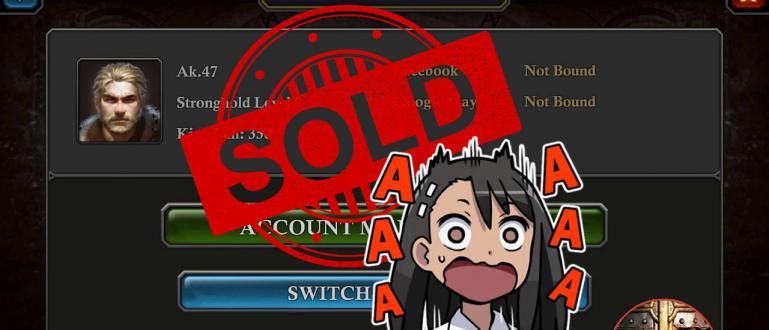Want to try to learn hacking easily? Easy, gang! You can learn basic CMD commands that are often used by hackers.
As we know it, Command Prompt is a tools the best default provided by Windows. Command Prompt is also known as CMD.
By learning certain tricks in CMD, you can do anything through your PC.
Previously, Jaka had given an article about CMD, namely 100+ CMD (Command Prompt) Commands You Must Know.
Well, some of them, turned out to be commonly used to do hacking. If you are curious, ApkVenue will tell you the 7 most basic CMD hack commands that hackers often use.
CMD Hack Commands Often Used by Hackers
If you aspire to be a programmer, or even a hacker, you really have to learn about the commands in Windows CMD, gang.
To input the CMD command below, you can follow this short guide:
- Use shortcut keys Windows + R on the keyboard.
- Type CMD, then press Enter.
- Finished! Then you can enter the command as you wish.
If you're looking for a way to hack a website with cmd, maybe you can use the following basic commands, gang.
1. Ping

CMD Hack Command Ping used by using an Internet connection to send multiple files data plan to a specific site, and this package will return it to your PC.
Well, this command will also show the amount of time it takes to reach a certain address. Simply put, it helps you to see if host what are you doing Ping is it still alive or not.
You can use the Ping command to verify whether the PC can connect to a TCP/IP network or not. Here's the guide!
- Open CMD.
- Type ping 8.8.8.8 to go to Google. Finished!
Well, you can change this 8.8.8.8 to www.google.co.id or any other site you want to Ping.
2. Nslookup

Nslookup is a CMD Hack command in the form of a tools which contains the network command line. This will help you to get a name domain or IP address mapping for DNS records certain.
For example, you have a website URL and want to know IP Address, you can use this type of command. Here's the guide!
- Open CMD.
- Type nslookup URL address space. Examples like this, nslookup jakakeren.com.
- Finished!
Well, this way you can know and be able to find the IP address used on the URL of Jaka's website. If you have a website URL, jakakeren.com it's just replaced with the one you have.
3. Tracert

Besides Tracert, you can also say it as Trace Route. As the name implies, you can use this command to trace the route of a predefined IP address.pack and already taken to reach the destination.
This command will calculate and display the number of each jump required to reach that destination. Here's the guide!
- Open CMD.
- Type tracert (IP address), or you can use tracert (website address), suppose tracert jakakeren.com.
- Finished!
The second option is used if you don't know the IP address of the site. You can also read Jaka's article entitled How to Check the Most Accurate IP Address on HP & Laptops.
 VIEW ARTICLE
VIEW ARTICLE 4. ARP

This CMD hack command will help you to modify ARP cache. You can run this command on any PC.
This is done to see if the PC has MAC address correct and registered to others, to Ping each other whether successful in subnet the same one.
This command can also help you find out if someone is playing pranks on your computer's LAN. Here's the guide!
- Open CMD.
- Type arp -a on the Command Prompt.
- Finished!
5. Ipconfig

The CMD hack Ipconfig command is a really cool command. You see, this one command is able to show everything that is useful.
Such as IPv6 addresses, temporary IPv6 addresses, IPv4 addresses, Subnet Mask, Default gateway, and other things you want to know more about.
To try it, you can see the guide below:
- Open CMD.
- Type ipconfig or ipconfig/all in the Command Prompt.
- Finished!
6. Netstat

This CMD hack Netstat command is important enough for you to know who is establishing a connection with your computer without permission.
For that, you can follow Jaka's guide below:
- Open CMD.
- Type netstat -a to see all active connections.
- Or, type netstat -n to view the name of the program that accesses the network service.
- Or, type netstat -an to see both at once.
Well, you can also read more about how to block users without permission through Jaka's article entitled How to Block Illegal WiFi Users.
 VIEW ARTICLE
VIEW ARTICLE 7. Route

The last most basic CMD hack command on this list is Route. The Route command has the function of routing the computer to a LAN or WAN network.
Not only that, in addition, you can also find out the process of network traffic, information on host paths, gateways, and network destinations.
Oh yeah, the Route command actually has the same function as the Netstat command, to be exact netstat -r, you know.
For the guide, you can see Jaka's steps below:
- Open CMD.
- Type route print.
8. Netuser

The netuser command is typically used to add, delete, and make changes to user accounts on a computer.
One of them, you can also reset your computer password without needing to know the old code combination.
It's very easy, here's a guide! 1. Open CMD. 2. Type net user yourusername, where "yourusername" is replaced with the name of your PC username.
9. NetView

CMD Net view is used to see which computers are currently active and connected to your LAN network.
That way, you can know which ones can be considered intruders or not. It's very easy, here's a guide:
- Open CMD.
- Type netview x.x.x.x or netview computername.
- In section "x.x.x.x"fill in the IP address, while "computername" with the name of your PC.
10. Tasklist

Tasklist is a command to display the entire list of Task Manager at the Command Prompt.
Yep! Later you can see the entire list of applications and services that are running on your Windows.
The guide is also very easy. Suppose you want to end the PID 1532 process, here are the steps:
- Open CMD.
- Type taskkill /PID 1532 /F.
Well, that's easy way to hack just by using the Command Prompt command. There are still many CMD commands that you can learn. Give your opinion yes!









